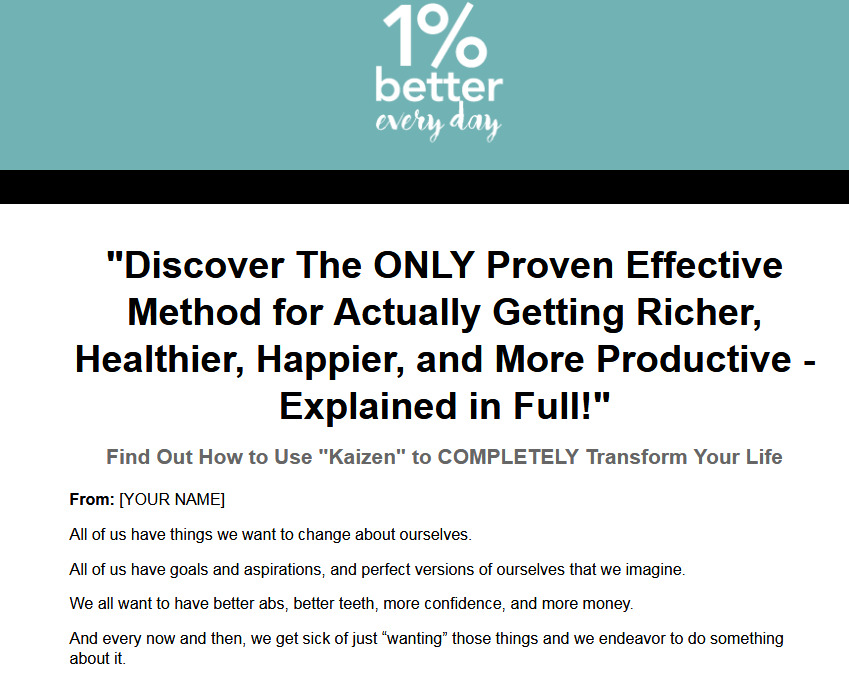Salespage Snapshot

Table of Contents
Introduction . 5
Chapter 1: Why We Need Kaizen .. 7
The Neuroscience 9
How it Happens .. 11
Chapter 2: Kaizen in its Original Context: Business … 12
The Origin of Kaizen …. 13
Types of Kaizen . 14
Simplify and Eliminate Waste . 15
Chapter 3: Kaizen Concepts to Consider . 19
The 5S of Kaizen 22
The Opposite of Kaizen: Kaikaku 23
Chapter 4: Kaizen for Getting Into Shape – Health and Fitness 24
Microworkouts …. 25
True Kaizen and Getting Into Shape 27
Powerful Changes For Improving Fitness .. 29
What Can Go? …. 29
Where To Fit It In? … 29
More Small Fixes 30
The Takehome …. 31
Chapter 5: Kaizen for Personal Finance … 32
Creating a More Efficient Budget 33
Monitor and Improve 34
Plan for the Unexpected …. 35
Limit Your Cash Flow …. 35
Make Rewards …. 36
Use Apps .. 36
The Takehome …. 37
Chapter 6: Kaizen for Productivity and Business … 38
Find the Sticking Points 39
Sticking to Your New Rules and Avoiding Errors With Checklists and Flow
Charts .. 40
Flow Charts for Dealing With Problems . 41
Chapter 7: Life Hacks and Biohacks …. 43
Temperature May Be The Key To Good Sleep …. 44
How To Wake Up On Time Every Time 45
The Best Supplements . 47
Inspiration Hacks 48
Dress to Impress 49
Intermittent Fasting . 50
Chapter 8: Finding Balance … 51
Input and Output 52
Staying Positive .. 52
Make the Most of Now . 53
Closing Comments .. 55
Sample Content Preview
Chapter 2: Kaizen in its Original Context: Business
Kazien is a term that has very much been adopted by the selfimprovement crowd and that is popular among everyone who hopes to become happier, fitter, wealthier, and wiser. But it began like as a business term, and understanding its routes in this way can go a long way to helping us grasp the concept and better apply it to our own lives.
And if you happen to run a business, then of course you’ll find all of this useful for its own merits.
The Origin of Kaizen
The word kaizen means “improvement” or “change for the better” in Japanese. However, the term is used more specifically to refer to continuous improvement, or small changes.
The term Kaizen first adopted this meaning in the world of business. This was especially pertaining to the methodologies of car manufacturer Toyota, initially. The strategy has been successfully adapted to business for many organizations, and later to the self-improvement field. The book Toyota Way explains the use of Kaizen in detail and has canonized its usage to some extent.
That said, the self-improvement crowd has also somewhat applied a little artistic license to the way it uses kaizen. In many ways, self-help books tend to oversimplify Kaizen, while others misinterpret some of the core concepts.
Kaizen is all amount focussing on the minutiae. On making small changes that add up to big differences. But whereas many selfhelp books tell you that this translates to “flossing your teeth” a little every day to ingrain new habits, that isn’t actually anything to do with the original meaning of the word.
That isn’t to say that this advice doesn’t have merit. We will be discussing all types of kaizen in this book, but by addressing the
strictest business interpretation first, we’ll also understand the “official” version – which just so happens to also be extremely powerful and often overlooked.
Types of Kaizen
In business, in its original context, Kaizen has been generally broken down into two separate terms:
• Flow kaizen
• Process kaizen
In flow kaizen, the approach looks at a “value stream.” This might be a whole work flow, in which the organization can look for different opportunities to improve the process.
If you imagine a large production line that involves several stages. While making a tiny change at each step of the way won’t seem to have a big impact on its own, when taken as a whole, all those tiny improvements can potentially have a huge result.
Process kaizen on the other hand is the “concentrated improvement of a single process.” That means looking at one step and making constant small improvements to get it to the point where it is the best it can be.
Kaizen is often described as being “bottom up,” meaning that you start by looking at the most fundamental levels and making small
changes there. You can potentially improve every aspect of your business by cleaning the floors. Why? Because cleaner floors mean fewer accidents and happier staff. That leads to more efficient storage and retrieval. That leads to more funds left over, and happier customers. That leads to more moral and more R&D. The result is better products, and a better brand image.
Simplify and Eliminate Waste
Moreover, Kaizen is also about looking to eliminate waste. In any given process, there is almost always “waste” that can be eliminated. By getting rid of these errors, you can significantly
increase the speed of a process. This can have huge and transformational changes for a business.
Let’s imagine for a moment that you are someone who writes articles for a big blog and uploads them to WordPress every day (WordPress being an online publishing platform). When you upload the article, you need to add images and formatting like bolding and headers etc.
So your current workflow looks like this:
• You write your article
• You read through your work and check for typos
• You upload the article to WordPress
• You read through your work and upload images and add formatting
What’s wrong with this? Well nothing on the face of it, except that by taking this approach, you’re not working in the most efficient way possible. That’s because you’re currently reading through everything you wrote twice. That’s once to make sure that it is spelled correctly and once to add images.
So why not:
• Write the article
• Upload it to WordPress
• Read through it and fix typos while formatting
This has effectively combined two steps into one step that will take slightly longer than either on its own, but will be much quicker than doing both. And that in turn can potentially save you a large amount of time and effort in the long run.
Let’s say this saves you 10 minutes per article, and that you upload 10 articles per day. That’s 100 minutes back and perhaps this now means you can afford to upload an additional article? If so, you might now be able to earn an extra $30 a day.
As a sole trader, you might use Kaizen therefore to earn an extra $30 every single day without increasing your rates, working harder, or otherwise changing anything about your business! And kaizen is always relentless. Because there’s still probably waste here.
What if you could remove the time spent uploading by writing directly into WordPress? And what if you batched all of your proofing and formatting together? Could that save you more time? Kaizen is constantly looking for waste like this and opportunities to streamline and improve flows and processes.
Here are a few examples of types of “waste” that a Kaizen practitioner might look for in a typical business:
• Defects – Poor copies, mistakes, errors
• Excess processing – Repairs
• Overproduction – Overestimating demand
• Waiting – Waiting for the next step in the chain to become ready
• Inventory – Waiting on stock/supplies/materials
• Transportation – Time spent transporting people or goods
• Moving – Excessive movement of machines or people
• Non-utilized talent – Utilizing skilled workers in a non-skilled capacity
While this type of kaizen might seem less obviously applicable to your personal life, the truth is that it can be immensely powerful if you look at your own processes.
Other Details- 20 Articles (TXT, DOC)
- 1 Ebook (PDF), 55 Pages
- 2 Graphics (JPG, GIF, PNG)
- 1 Salespage (HTML)
- Checklist, Resource Cheat Sheet, Mindmap, Optin Page, Social Media Images, Email Swipes
- Year Released/Circulated: 2019
- File Size: 34,636 KB
License Details:
[YES] Can be sold
[YES] Can be used for personal use
[YES] Can be packaged with other products
[YES] Can modify/change the sales letter
[YES] Can be added into paid membership websites
[YES] Can put your name on the sales letter
[YES] Can be offered as a bonus
[YES] Can be used to build a list
[YES] Can print/publish offline
[YES] Can convey and sell Personal Use Rights
[YES] Can convey and sell Resale Rights
[YES] Can convey and sell Master Resale Rights
[NO] Can modify/change the main product
[NO] Can modify/change the graphics and ecover
[NO] Can be given away for free
[NO] Can be added to free membership websites
[NO] Can convey and sell Private Label Rights














